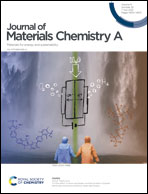Triggering the phase transition and capacity enhancement of Nb2O5 for fast-charging lithium-ion storage†
Abstract
Developing high energy density and high-power density electrode materials is of great importance for lithium-ion batteries to satisfy the requirements of the customer market. We report that introducing Mo into Nb2O5 at a low temperature leads to phase transition from bronze-phase T to crystallographic shear-phase H. The resulting Nb1Mo0.1O2.8 exhibits higher energy density than T-Nb2O5 and improved rate-performance and cycling-stability compared to H-Nb2O5. Neutron diffraction was applied to Nb1Mo0.1O2.8 to characterize the structure and two-phase ratios of the mixed metal oxide together with the first-principles method to calculate the possible Mo substitution sites. The Nb1Mo0.1O2.8 anode displays intrinsic pseudocapacitive lithium-ion intercalation with a high energy density of 362 mA h g−1 at 0.2C. In situ XRD results suggest that Nb1Mo0.1O2.8 is able to intercalate more lithium ions with smaller structure expansion compared with H-Nb2O5; furthermore, a computational method reveals that the introduction of Mo into the oxide increases Li atom adsorption energies and decreases the diffusion barrier. Therefore, Nb1Mo0.1O2.8 is a promising anode material for high-capacity and high-rate lithium-ion energy storage.



 Please wait while we load your content...
Please wait while we load your content...